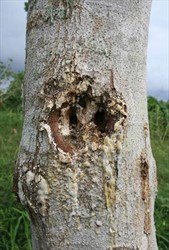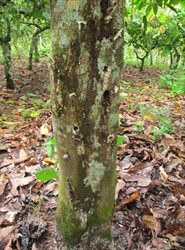Galip weevil. Galip is the Pidgin name in Papua New Guinea for Cararium species. It is also the name of the edible nut. The tree is a natural member of lowland rainforests of Melanesia (Papua New Guinea, Solomon Islands and Vanuatu) and is also native in eastern Indonesia, up to about 500 masl. The tree is valued for its nuts - for food and oil - as well as its timber.
Pacific Pests, Pathogens, Weeds & Pesticides - Online edition
Pacific Pests, Pathogens, Weeds & Pesticides
Galip (Canarium) weevil (537)
Ectatorhinus magicus. It belongs to the snout (or true) family of weevils, the Curculionidae.
Oceania. The weevil is native to Papua New Guinea. It was first described from New Guinea island in 1960, and subsequently from the Duke of York Islands, New Britain and New Ireland. Damage was first seen in about 2012 in plantations on the island of East New Britain (ENB) at Vunapau on the Gazelle Peninsular. Surveys have also shown it present in research plots at Keravat Research Station (ENB), and at Madang on the north coast of Papua New Guinea (New Guinea island).
Canarium indicum, and possibly other species. Two elite varieties selected for plantations are from Nissan Island and Buka Island, in the Autonomous Region of Bougainville.
Larvae do the damage by tunnelling in the trunks of Canarium, commonly leading to their death (Photo 1). Trees under 10 years of age (about 80 cm diameter at breast height) are the most susceptible. Signs of attack are loss of canopy, dead or dying branches (Photo 2), and holes commonly below the first branch with weeping resin that dries white (Photos 3&4).
Eggs have not been described. Larvae are creamy-white, with a brown head, black mandibles, and large breathing holes on the thorax, larger than those on the abdomen. Pupae are also creamy white and show the long snout. Adults are 2-3 cm long with long thin snouts, long, clearly jointed legs, and femurs with light brown and white banding (Photos 4&5). Top parts are light brown and cream interspersed with black. A thick, short, light brown and white cross is present in the middle of the back where the forewings fold together (Photos 5&6). Adults feign death when disturbed (Photos 7&8).
Mating takes place on tree trunks. Females excavate a small tunnel in the trunk, usually anywhere from ground level to 3 m, and lay an unknown number of eggs. Holes also occur on trunks just below ground level and on branches (but rarely). Second stage larvae are thought to do the most damage, feeding on the cambium and vessels, tunnelling both horizontally and vertically. Later larvae (third and fourth) attack the heartwood, but some stay near the bark in surface tunnels, or fall to the ground remaining under frass and soil at the base of the tree. Pupation is mostly within the tree, in the heartwood. Adults probably feed by scraping the surface layers of leaf stalks. The length of the life cycle is yet to be determined, but is thought to be about 6 months.
Spread of the weevil over short distances by walking, and perhaps other yet unknown means.
In 2006, galip weevil was reported as a minor pest of Canarium indicum in Papua New Guinea. It is now considered to be a pest of major concern. Surveys in 2015 found that weevil damage was present and severe throughout the Gazelle Peninsular, in both smallholder plots (up to 100 trees) and large plantations (about 6000 trees). In many places 90% of trees were dead or dying. The similar age of the plantations and their low genetic diversity puts them at high risk.
The surveys considered the galip weevil an emerging pest of concern to the sustainability of elite galip plantings across the Gazelle Peninsular and potentially other provinces in Papua New Guinea. This was confirmed by further surveys in 2017 that described the weevil as "having a catastrophic impact on the fledgling galip industry [of Papua New Guinea"].
Look for galip trees with dieback, holes in the trunk releasing resin (drying white) and whitish larvae with brown heads, tunnelling in the cambium, vessels and heartwood. Look for adults, 2-3 cm long, with long, light brown and white striped legs, brown and cream mottled bodies, with a distinctive brown and white cross on the back.
BIOSECURITY
The galip weevil has a narrow distribution. In Papua New Guinea, but also in adjacent countries where galip nuts are an important commodity, consideration should be given to potential spread of the weevil. A priority is a better understanding of the weevil's life history in order to have sound regulations for the movement of Canarium and its products.
NATURAL ENEMIES
None known, but the use of ants, such as the yellow crazy ant, Anoplolepis gracilipes, for control of Pantorhytes species in cocoa (see Fact Sheet no. 61), and the green (also called weaver) ant, Oecophila smaragdina, for control of the red-banded caterpillar, Deanolis sublimbalis, of mango (see Fact Sheet no. 281), have been suggested.
CULTURAL CONTROL
During growth:
- Hand picking. Where galip blocks are relatively small (100 trees or less), routinely collect adult weevils; and where holes are seen (look for frass and/or resin) use wires to kill larvae in the tunnels.
- Do not stress trees by cutting the bark with knives or machetes; otherwise, plant volatiles may be released which attract galip weevils.
- Do not stress trees by burning rubbish at the base and damaging the trunks and/ roots; this may increase susceptibility of trees to attack by galip weevil.
VARIETAL RESISTANCE
There is no evidence of different tolerance between galip varieties to galip weevil in ENB trials; however, assessment was made difficult due to a lack of data on the origin of the seedlings. The resistance of wild varieties is unknown.
CHEMICAL CONTROL
The application of insecticides into the holes in the trunk to kill the larvae may have potential. Tests are needed using synthetic pyrethroids and possibly systemic products. If done, residue analyses of oils and nuts would be obligatory.
____________________
When using a pesticide, always wear protective clothing and follow the instructions on the product label, such as dosage, timing of application, and pre-harvest interval. Recommendations will vary with the crop and system of cultivation. Expert advice on the most appropriate pesticides to use should always be sought from local agricultural authorities.
AUTHOR Grahame Jackson
Information (and Photos 1-3) from Galip weevil of Papua New Guinea. Fact Sheet. ACIAR, NARI, UNSW, Australian Museum; and (plus Photos 4&5) from Cassis G, et al. (2017) Life history, identity and damage assessment of galip weevil. Final Report. ACIAR, Canberra. 63pp.
Produced with support from the Australian Centre for International Agricultural Research under project HORT/2016/185: Responding to emerging pest and disease threats to horticulture in the Pacific islands, implemented by the University of Queensland and the Secretariat of the Pacific Community.











